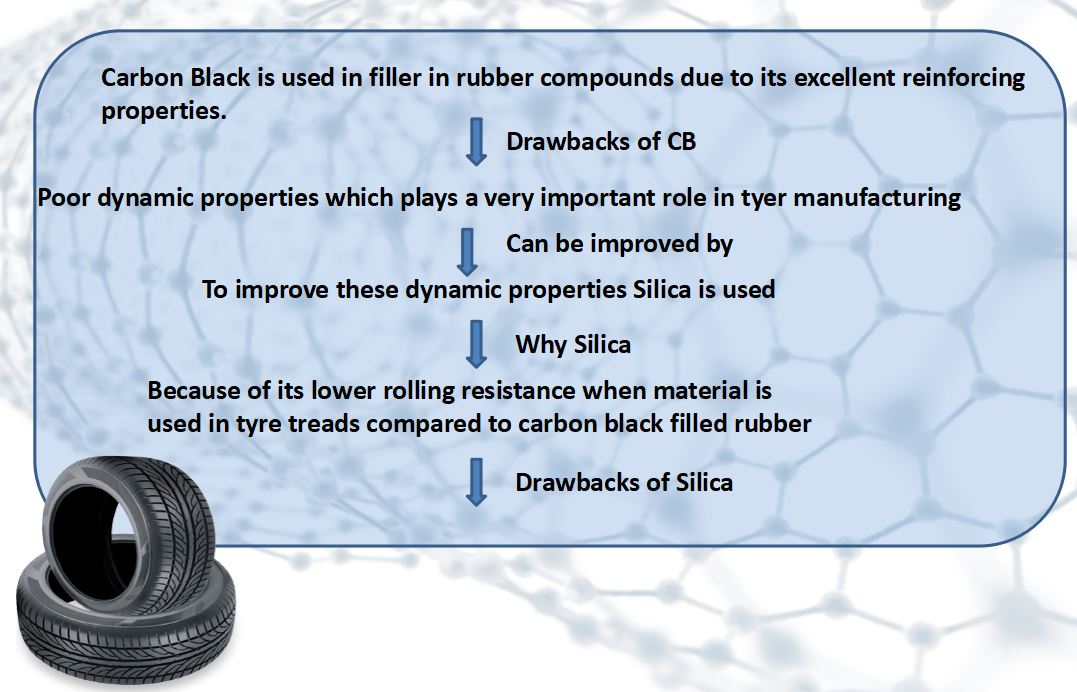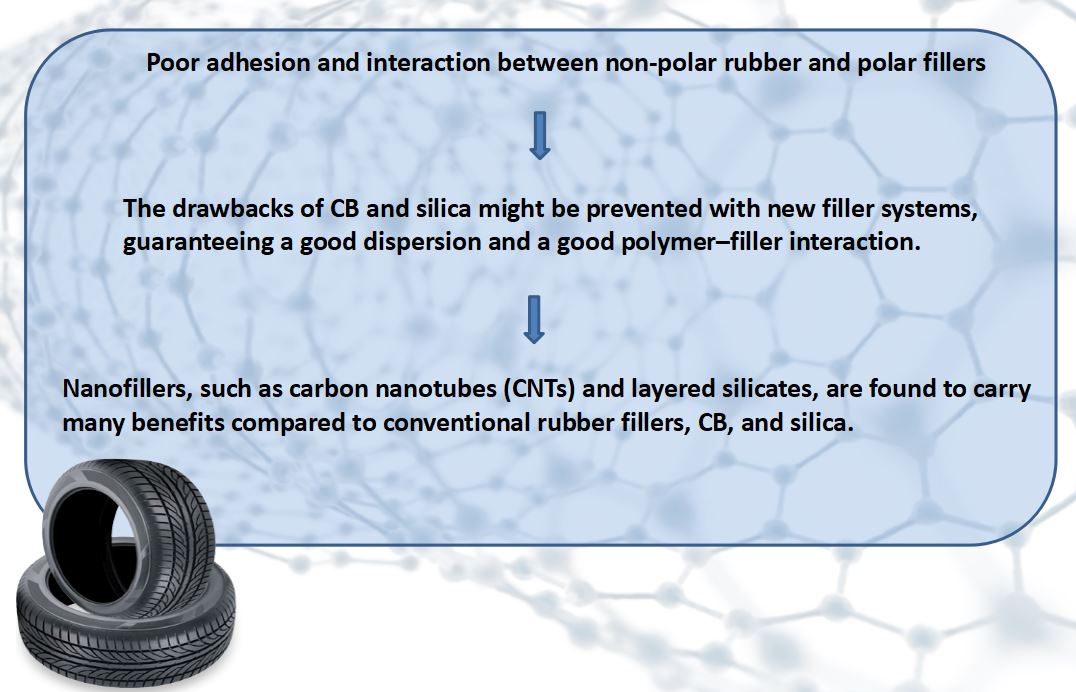Nanomaterials in Tyre Manufacturing
Apologies for using the spelling ‘Tyre’ instead of ‘Tire’ – We are a UK based company!
During the past 2 years we have been involved with helping tyre manufacturers around the world develop new tyres that contain nanomaterials.
We have decided to write this page as we get numerous requests for information relating to this subject and thought it might be useful to share some of our research.
Unfortunately much of the work we have done in this field is ‘proprietary as we have been paid by individual tyre companies to work on specific projects – but we are able to share some generic information that doesn’t breach any of our non disclosure agreements.
If after reading this article you wish us to help you with your research or supply you with appropriate nanomaterials, we would be happy to talk with you to to discuss how our expertise could help.
Background
The need for higher performing and ‘greener’ tyres has never been higher. For many years Carbon Black has been used as a filler but this is inefficient and environmentally unsound.
Benefits of using Carbon Nanotubes (CNT’s) instaed of Carbon Black (CB) in tyre manufacture
Summary : Lower rolling resistance, lighter weight and superior performance.
Owing to its tubular form, multiwalled carbon nanotubes (MWCNTs) have a high aspect ratio and therefore have good reinforcing effect when used as a filler in rubber. Tyres enhanced with CNT (carbon nanotubes) have improved mechanical properties, such as tensile strength, tear strength and hardness of the composites, by almost 600%, 250% and 70% respectively, comparing with those of the pure SBR composites (styrene‐butadiene rubber).


| Properties | Carbon Nanotubes (CNT’s) | Carbon Black |
| 1. Structure | Consist of Sp2 bonds only. | Consist of a mixture of sp2 and sp3 hybridization |
| These bonds are stronger in nature. | This hybridization causes defects. | |
| No bottled pores/ dead ends Full surface is available for reaction | Due to this the surface became highly porous not all the surface can be utilized | |
| 2.Material Weight | The overall material weight is reduced by using CNTs | More CB is required to achieve the same volume fraction. |
| Same wt% of CNTs as that of CB, increases total volume fraction of the fillers which directly affects moduli values of tyres. |
More carbon black is required | |
| The overall weight of the tyre reduces. |
Overall weight of the tyre increases, also loss in mechanical properties are also noticed. | |
| 3. Aspect Ratio | Higher aspect ratio | Lower aspect ratio |
| Good reinforcing effect | The reinforcing effect decreases. More CB will be required to make the filler | |
| The weight of the tyre will be reduced leading to improved effeciency. | Overall weight of the tyre increases. | |
| Value: 1250-3750 (For functionalized MWCNTs) | Value: close to 1 | |
| 4. Modulus Value | As the filler-filler interaction is higher using CNTs, the modulus value is ultra high. | Weaker filler-filler interaction leads to lower modulus value. |
| It restricts the changes in polymer molecular configuration | Due to lower modulus, molecular configuration of polymer can change | |
| Enhances the modulus of the rubber composites. | ||
| Modulus Value= 1.2Tpa | Modulus Value= 13.2Mpa | |
| 5. Surface Area | Higher surface area | Lower surface area |
| This enables improved interactions with rubber chains This leads to stronger bonds. | Interaction with rubber chain is poor, this leads to weaker bonds. | |
| Due to increased chemical reactivity there is an increase in friction. | Due to lesser surface area, the friction decreases. | |
| The grip improves leading to higher efficiency of tyres. | The grip is poor as compared to that made with CNTs. | |
| Value: 1315m2/g | Value: 27-145m2/g | |
| 6. Scorch Time | Shorter Scorch time, which is the measurement of premature vulcanization. | Longer scorch time |
| Curing time is reduced due to the additions of CNTs in natural rubber | Longer curing time. | |
| Eliminates the difference in cross linking degree between the surface and inside of the thick rubber. |
The vulcanization rate decreases. | |
| 7. Strain | Low strain | High Strain |
| Storage modulus at low strain gradually increases illustrating strong network formation by CNTs |
Due to higher strain values the network formation is poor. | |
| As the network formed is stronger the tyre produced using CNTs will also be strong. | Poor network formation means weaker bonds thus weaker tyre. | |
| 8. Density | Lower density | Higher Density |
| Volume fraction of fillers is increased by addition of CNTs. | Leads to decrease in volume fraction of fillers. | |
| Value: 2.6g/cm3 | Value: 1.8-2.1 g/cm3 | |
| 9. Thermal Conductivity | Tyre efficiency increases. | Tyre efficiency decreases. |
| Value: 2000~6000 W/mK at 25°C. | Value:6~174 W/mK at 25°C. | |
| 10.Thermal stability | Addition of CNTs increases the thermal stability. | CB can improve the thermal stability but not to that extend as CNTs can. |
| The increased thermal stability shows various improvements as CNTs can impose the restriction on the mobilization of rubber macromolecules. |
Heat sinks are created. | |
| As the thermal stability is more, the lifetime of the tyre increases. | As thermal stability is not higher therefore lifetime of tyres made by CB is lesser than those made from CNTs. |
|
| 11.Filler interaction | MWCNTS agglomerates ,thus increasing surface area which leads to higher filler-filler interactions. | Weak filler-filler interactions. |
| Better adhesion | Adhesion is not good as compared to CNTS. |
Production Process
In situ polymerization is one of the most popular methods to incorporate CNTs into a polymer matrix. By this method, poly (methyl methacrylate)/ styrene/MWCNTs co-polymer composites, polystyrene/ acrylonitrile/MWCNTs composite, and polyacrylonitrile/ methylmethacrylate/MWCNT copolymer composites etc. have been successfully fabricated.
Basic method to introduce CNT in Tyre rubber
1. Take the Raw material Natural Rubber and Chemicals
2. Compounding and Mixing: Compounding is the operation of bringing together natural
rubber, process oil, CNT, accelerator and other additives, each of which contributes
certain properties to what is called a ‘compound’. To obtain a homogeneous mixture, they are mixed at high temperatures.
3. Component Preparation:
(a) Extrusion – Process of applying heat and pressure on the compound and
additional mixing of the compound.
(b) Calendaring – Process of squeezing the compound into a thin sheet.
4. Tire building: As per the standard Method
5. Curing: As per the standard Method
Chemical method to introduce CNT into NR:
1. Soaking of NR in the Tetrahydrofuran (THF) for 6-8 hours.
2. Separately disperse the CNT 2-3% into the solvent(THF).
3. Add dispersed CNT in the above-mentioned solution of THF and NR.
4. Mechanical stirring is given for about 2-3 hour.
5. Followed by probe sonicate the solution for 10-20 minutes
6. Dry it at room temperature after which it could be added into the extrusion process.
Costs
One of the main motivations to use CNT’s in tyre manufacturing has been the great reduction in the cost of producing industrial quantities of CNT’s. The newly discovered method of production called Chemical Vapor Deposition has meant that in recent months CNT’s have reduced in price from around $300 per kilogram to under $100 – making it cost effective as usually only a 2% loading of CNT’s is required to achieve the performance enhancements required.
Our Materials
We supply high purity MWCNT’s in quantities for research (10g – 1kg) and in bulk quantities (1kg – 1,000kg) – We also supply over 2,000 other nanomaterials.
Our prices for MWCNT’s are as follows (We have a 4 acre production facility with a capacity to manufacture over 10,000kg of MWCNT’s per month, using a Chemical Vapour Deposition process)
| 10gm – 50gm | £19.75 per gm |
| 51gm – 100gm | £14.50 per gm |
| 101gm – 500gm | £8.25 per gm |
| 501gm – 1000gm | £5.75 per gm |
You can order our MWCNT’s online at https://inscx.com/shop/product/high-purity-mwcn-purity-99-od-15-25nm-length-5-15%c2%b5m/
We deliver globally via DHL with an average delivery time of 7 days.
We are an ISO9001 Quality Assurance registered company with an 8 year trading history in supplying nanomaterials and nano consultancy.